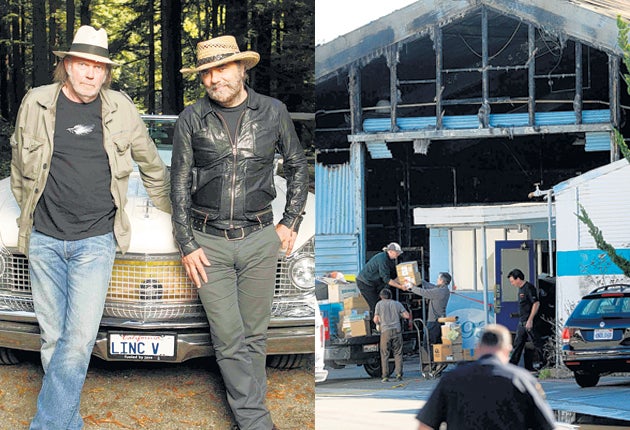The Lincoln and the damage done
Neil Young's memorabilia warehouse burns down – and adapted eco-car that inspired album is to blame

When singer-songwriter Neil Young converted his 1959 Lincoln Continental to run on biofuel, his plan was to drive it from Wichita, Kansas, halfway across the United States to Washington, DC, to show politicians that America's longstanding love affair with the automobile need not be sacrificed upon the altar of environmentalism.
He will have been disappointed to discover that the vehicle's charging system was responsible for a blaze at a warehouse that has seen a million dollar's worth of the enduring rock musician's prized paintings and guitars go up in planet-poisoning smoke.
Firefighters in California managed to save 70 per cent of the warehouse's contents after the fire broke out, but damage has been estimated at up to $1m (£620,000). Young has kept guitars, paintings, photographs and several classic cars at the warehouse in the San Francisco Bay area, near his home on Broken Arrow Ranch. The singer's spokesman is yet to confirm which items may have been lost but Fire Marshal Jim Palisi confirmed that "a lot of it is musical instruments and electronic equipment. It's very expensive."
The singer has praised the emergency services' role in saving many "archival items", suggesting the fire will not delay the creation and release of the Canadian's Archives project.
Chrome Dreams, Homegrown and Oceanside-Countryside were said to be among the previously unreleased albums being recreated for his Archives Volume 2 this year.
Young has blamed the fire on "human error", saying that the wall charging system should not have been left unattended, while authorities seem to be blaming the vehicle.
"The car was plugged in to charge and left unattended," Young wrote. "The wall charging system was not completely tested and had never been left unattended. A mistake was made. It was not the fault of the car." A statement on the website Lincvolt.com, where the singer publicises his experiments with his vintage biofuel vehicle, suggests the car's role in the torching of beloved treasures hasn't dampened his enthusiasm for the project.
"We are rebuilding," he wrote. "The reason we started this project has not changed. We're still in a race against time. On a project like this, setbacks happen for a reason. Barn's burnt down. Now I can see the moon," he added, quoting the 17th-century Japanese poet and samurai Mizuta Masahide.
An identical 1959 Lincoln Continental has since been acquired after the fire last Wednesday, a 65th birthday gift from his wife, Pegi, and work is already underway cannibalising its parts for the benefit of its blackened biofuel-burning cousin, which runs with the aid of what its website calls "super-safe" lithium iron phosphate batteries.
The converted car was the inspiration for Young's 2009 album, Fork in the Road, for which he was nominated for Best Solo Rock Vocal Performance at this year's Grammy Awards.
Young says his mission "is to inspire a generation by creating a clean automobile propulsion technology that serves the needs of the 21st century" and that he will have succeeded when "one or more major companies are building automobiles that use our technology or something similar".
That the technology has, in the ever-so-slightly amended words of his famous country cover, kept the home fires burning is something of a setback.
Join our commenting forum
Join thought-provoking conversations, follow other Independent readers and see their replies
Comments
Bookmark popover
Removed from bookmarks